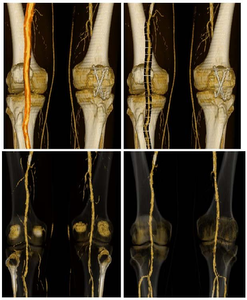Information
- Publication Type: Technical Report
- Workgroup(s)/Project(s): not specified
- Date: April 2004
- Number: TR-186-2-04-04
- Keywords: vessel visualization., focus & context technique, curved planar reformation, direct volume rendering
Abstract
Reliable and complete blood-vessel segmentation is still a challenging problem. This is especially true in the presence of morphologic changes resulting from atherosclerotic diseases. In this paper we take advantage of partially segmented data with approximately identified vessel centerlines to comprehensively visualize the diseased peripheral arterial tree. We introduce the VesselGlyph as an abstract notation for novel focus & context visualization techniques of tubular structures such as contrast-medium enhanced arteries in CT-Angiography (CT-A). The proposed techniques combine direct volume rendering (DVR) and curved planar reformation (CPR) within a single image. The VesselGlyph consists of several regions where different rendering methods are used. Region type, the used visualization method and region parameters depend on the distance from the vessel centerline and on viewing parameters as well. By selecting proper rendering techniques for different regions, vessels are depicted in a naturally looking and undistorted anatomic context. In this paper we furthermore present a way how to implement the proposed techniques in software and by means of modern 3D graphics accelerators.Additional Files and Images
Weblinks
No further information available.BibTeX
@techreport{Straka-2004-TVG,
title = "The VesselGlyph: Focus & Context Visualization in
CT-Angiography",
author = "Mat\'{u}s Straka and Michal Cervenansk\'{y} and Alexandra La
Cruz and Arnold K\"{o}chl and Milo\v{s} \v{S}r\'{a}mek and
Eduard Gr\"{o}ller and Dominik Fleischmann",
year = "2004",
abstract = "Reliable and complete blood-vessel segmentation is still a
challenging problem. This is especially true in the presence
of morphologic changes resulting from atherosclerotic
diseases. In this paper we take advantage of partially
segmented data with approximately identified vessel
centerlines to comprehensively visualize the diseased
peripheral arterial tree. We introduce the VesselGlyph as an
abstract notation for novel focus & context visualization
techniques of tubular structures such as contrast-medium
enhanced arteries in CT-Angiography (CT-A). The proposed
techniques combine direct volume rendering (DVR) and curved
planar reformation (CPR) within a single image. The
VesselGlyph consists of several regions where different
rendering methods are used. Region type, the used
visualization method and region parameters depend on the
distance from the vessel centerline and on viewing
parameters as well. By selecting proper rendering techniques
for different regions, vessels are depicted in a naturally
looking and undistorted anatomic context. In this paper we
furthermore present a way how to implement the proposed
techniques in software and by means of modern 3D graphics
accelerators.",
month = apr,
number = "TR-186-2-04-04",
address = "Favoritenstrasse 9-11/E193-02, A-1040 Vienna, Austria",
institution = "Institute of Computer Graphics and Algorithms, Vienna
University of Technology ",
note = "human contact: technical-report@cg.tuwien.ac.at",
keywords = "vessel visualization., focus & context technique, curved
planar reformation, direct volume rendering",
URL = "https://www.cg.tuwien.ac.at/research/publications/2004/Straka-2004-TVG/",
}


 paper
paper
